Roofing Companies Spalding
Top Roofing Company in Spalding
Get 3 FREE Roofing Contractor quotes for your project today! Compare profiles, reviews, accreditations, portfolio, etc... and choose the best offer.

Peterborough Improvements
4.588 reviews123 Main St, Peterborough, PE1 1XX, GBWelcome to Peterborough Improvements, the No.1 Home Improvement and Property Maintenance Company. We have the know-how to take care of all your home improvement or property maintenance needs, with professionals in every area. Whether you want to convert your garage into a new living space or have your garden designed and landscaped from scratch, we can take care of your project from start to finish. For your free consultation, give our friendly team a call today on 01733 306022. We offer a wide range of services including Driveways, Fencing and Gates, Decking, Roofing Installations and Repairs, Dropped Kerb Installation, Garden Services, Landscaping, Patio and Paving Areas, Garage Conversions, House Extensions & Building Work, Bespoke Garden Rooms & Mancaves, Smart Home Installation, Windows and Doors, Kitchen Fitting, Tiling, Floor and Carpet Fitting, and Cleaning Services.
- Services
- Why Us?
- Accreditations
- Gallery
Get Quote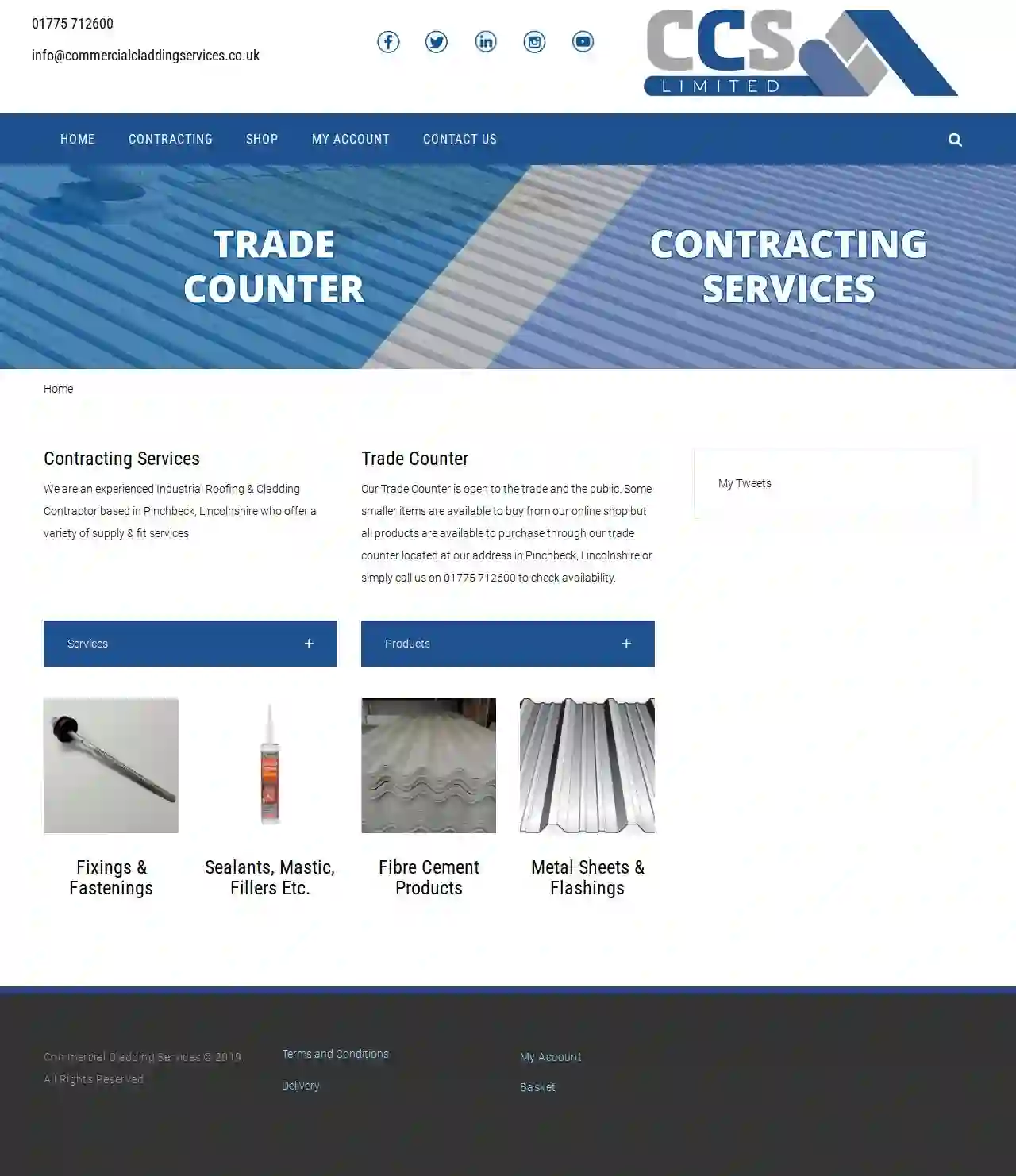
Commercial Cladding Services Ltd
56 reviewsPinchbeck Industrial Estate, Pinchbeck, Unit 1, PE11 3RY, GBCommercial Cladding Services Ltd is an experienced Industrial Roofing & Cladding Contractor based in Pinchbeck, Lincolnshire. We offer a variety of supply & fit services for new Industrial/Agricultural buildings. Our Trade Counter is open to both trade and the public. While some smaller items are available online, all products can be purchased through our trade counter located in Pinchbeck, Lincolnshire. You can also call us on 01775 712600 to check availability. Our services include roofing and cladding for new Industrial/Agricultural buildings, composite sheeting, single skin sheeting, fibreglass insulation, GRP roof lights, repairs to existing buildings, over-sheeting existing buildings, end lap treatment for metal roofs, gutter clearing, plygene lining to existing gutters, replacement guttering & downpipes, and internal firewall partitions. We also offer a wide range of products, including self-drilling tek screws, coloured moulded headed self-drilling tek screws, coloured rivets, self-drilling baz fixings for fibre cement, hook bolts, various washers, various sealants & mastics, profiled foam fillers, dektite’s – pipe flashings, fibre cement sheets, aluzinc steel profiled sheets, plastsiol coated steel profiled sheets, plastisol coated steel flashings, grp profiled roof lights, pvc rainwater products, various tool accessories, various PPE, and much more! If you require any further information or have specific needs, please don't hesitate to call us on 01775 712600 to discuss your roofing needs. We offer free no obligation quotations.
- Services
- Why Us?
- Gallery
Get Quote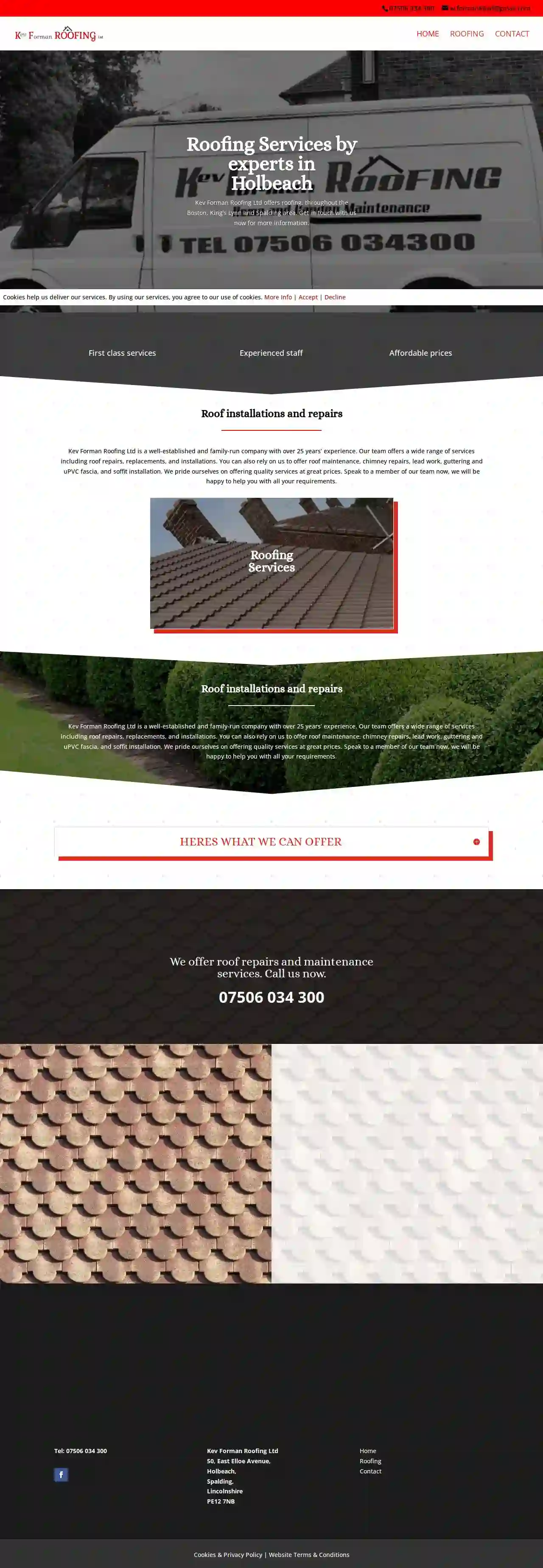
Kev Forman Roofing
3.58 reviews50, East Elloe Avenue, Holbeach, PE12 7NB, GBKev Forman Roofing Ltd is a well-established and family-run company with over 25 years’ experience. Our team offers a wide range of services including roof repairs, replacements, and installations. You can also rely on us to offer roof maintenance, chimney repairs, lead work, guttering and uPVC fascia, and soffit installation. We pride ourselves on offering quality services at great prices. Speak to a member of our team now, we will be happy to help you with all your requirements. Kev Forman Roofing Ltd offers roofing, throughout the Boston, King’s Lynn and Spalding area. Get in touch with us now for more information.
- Services
- Why Us?
- Gallery
Get Quote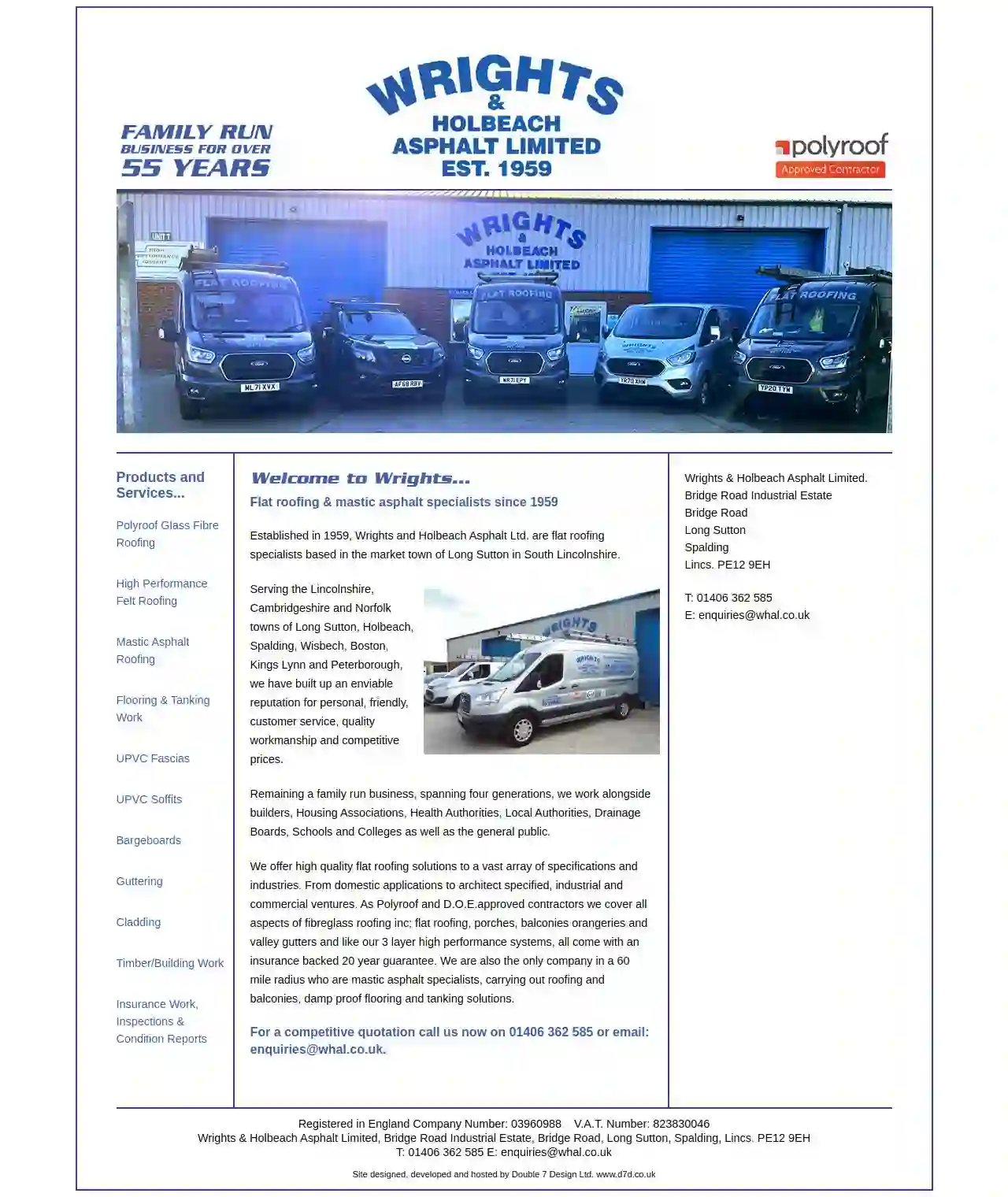
Wrights & Holbeach Asphalt Ltd
511 reviewsBridge Road, Bridge Road Industrial Estate, Long Sutton, PE12 9EH, GBEstablished in 1959, Wrights and Holbeach Asphalt Ltd. are flat roofing specialists based in the market town of Long Sutton in South Lincolnshire. Serving the Lincolnshire, Cambridgeshire and Norfolk towns of Long Sutton, Holbeach, Spalding, Wisbech, Boston, Kings Lynn and Peterborough, we have built up an enviable reputation for personal, friendly, customer service, quality workmanship and competitive prices. Remaining a family run business, spanning four generations, we work alongside builders, Housing Associations, Health Authorities, Local Authorities, Drainage Boards, Schools and Colleges as well as the general public. We offer high quality flat roofing solutions to a vast array of specifications and industries. From domestic applications to architect specified, industrial and commercial ventures. As Polyroof and D.O.E.approved contractors we cover all aspects of fibreglass roofing inc; flat roofing, porches, balconies orangeries and valley gutters and like our 3 layer high performance systems, all come with an insurance backed 20 year guarantee. We are also the only company in a 60 mile radius who are mastic asphalt specialists, carrying out roofing and balconies, damp proof flooring and tanking solutions. For a competitive quotation call us now on 01406 362 585 or email: . Wrights & Holbeach Asphalt Limited. Bridge Road Industrial Estate Bridge Road Long Sutton Spalding Lincs. PE12 9EH T: 01406 362 585 E: Registered in England Company Number: 03960988 V.A.T. Number: 823830046 Wrights & Holbeach Asphalt Limited, Bridge Road Industrial Estate, Bridge Road, Long Sutton, Spalding, Lincs. PE12 9EH T: 01406 362 585 E: Site designed, developed and hosted by Double 7 Design Ltd. www.d7d.co.uk
- Services
- Why Us?
- Gallery
Get Quote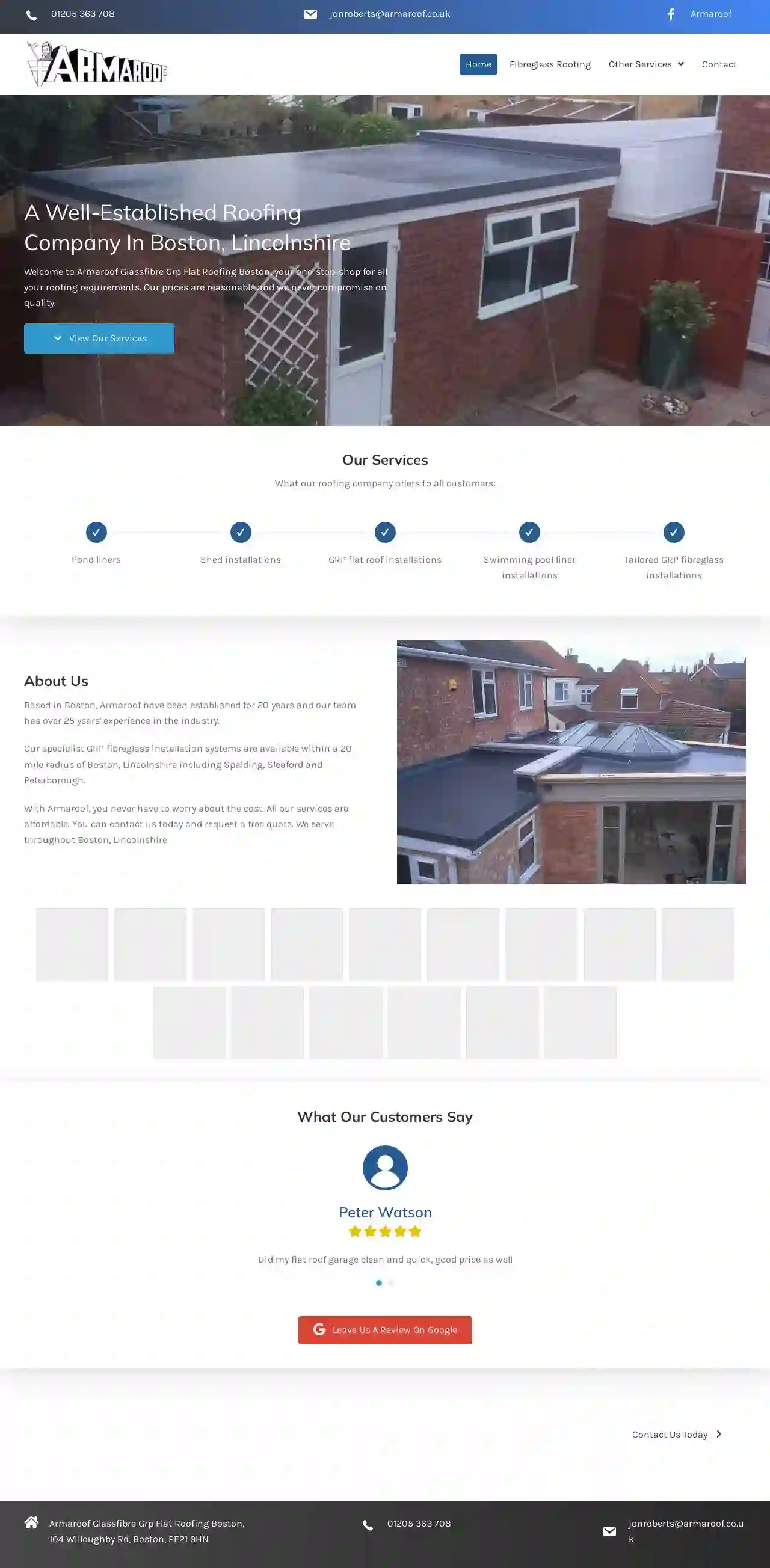
Armaroof Glassfibre GRP Flat Roofing
4.25 reviews104 Willoughby Rd, Boston, PE21 9HN, GBWelcome to Armaroof Glassfibre Grp Flat Roofing Boston, your one-stop-shop for all your roofing requirements. Our prices are reasonable and we never compromise on quality. Based in Boston, Armaroof have been established for 20 years and our team has over 25 years' experience in the industry. Our specialist GRP fibreglass installation systems are available within a 20 mile radius of Boston, Lincolnshire including Spalding, Sleaford and Peterborough. With Armaroof, you never have to worry about the cost. All our services are affordable. You can contact us today and request a free quote. We serve throughout Boston, Lincolnshire.
- Services
- Why Us?
- Our Team
- Testimonials
- Gallery
Get Quote
Damian Dale Leadwork Specialists
4.915 reviews3 Love Lane, The Vines, Spalding, PE11 2PE, GBWith over 25 years’ experience Damian Dale Leadwork Specialists are recognised as highly competent leadwork specialists and primarily work around the counties of Lincolnshire, Norfolk, Cambridgeshire, Leicestershire, and Rutland. However, we have completed successful projects throughout the UK. We have built a reputation for our in depth knowledge and high quality craftsmanship having worked on many prestigious developments and residential homes. We place great importance on the value of long term relationships with clients, employees, subcontractors and suppliers. These relationships are successful due to our core values of integrity, honesty, dedication and commitment.
- Services
- Why Us?
- Gallery
Get Quote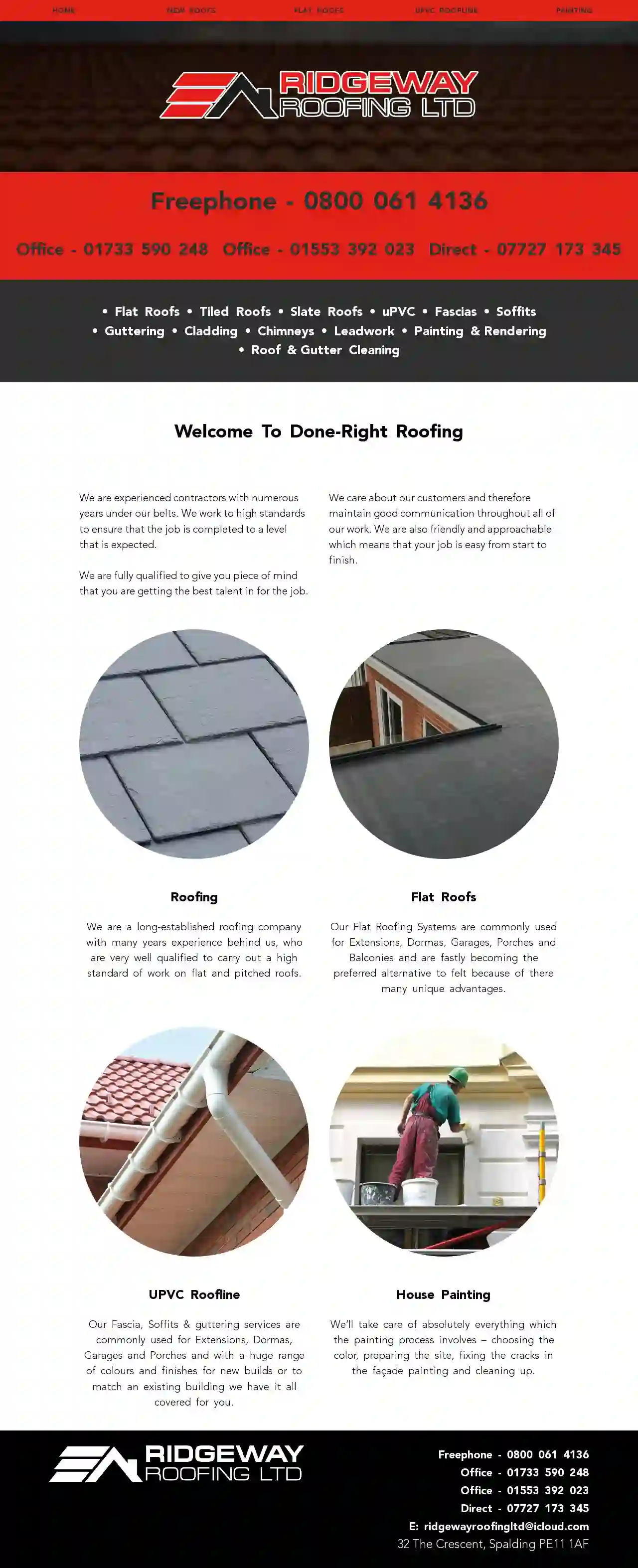
Ridgeway Roofing
32 The Crescent, Spalding, PE11 1AF, GBWe are a long-established roofing company with many years experience behind us, who are very well qualified to carry out a high standard of work on flat and pitched roofs. We are experienced contractors with numerous years under our belts. We work to high standards to ensure that the job is completed to a level that is expected. We are fully qualified to give you piece of mind that you are getting the best talent in for the job. We care about our customers and therefore maintain good communication throughout all of our work. We are also friendly and approachable which means that your job is easy from start to finish.
- Services
- Why Us?
- Gallery
Get Quote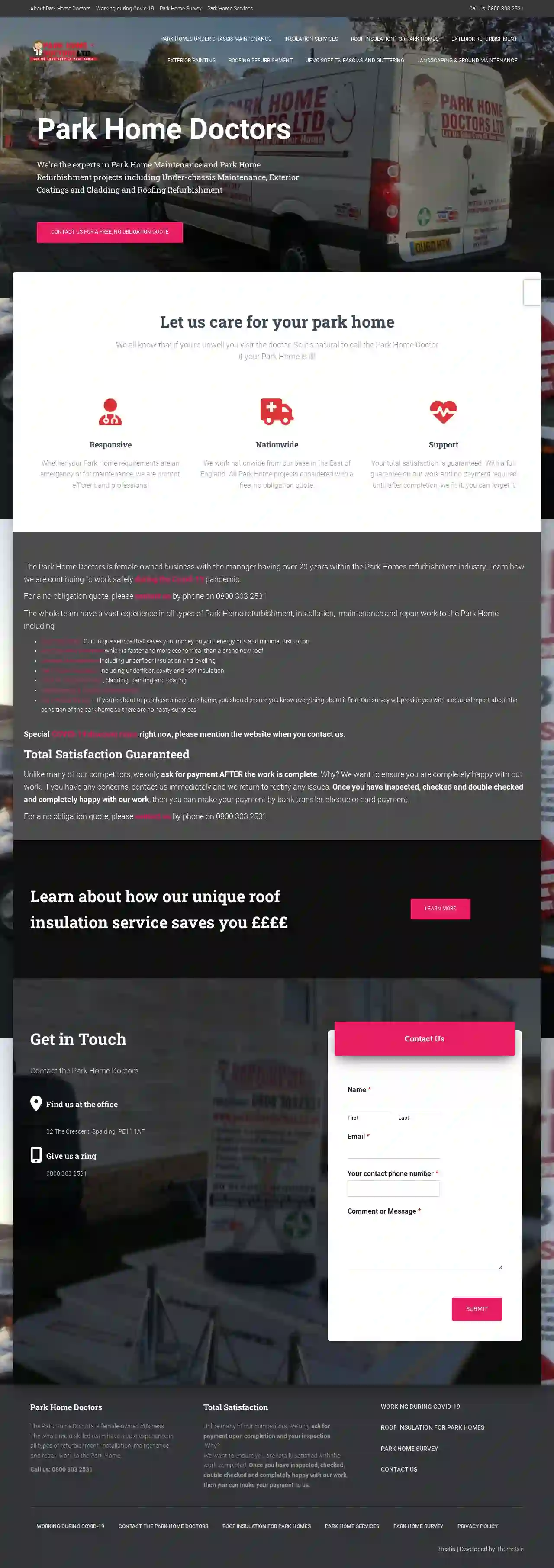
Park Home Doctors
4.416 reviews32 The Crescent, Spalding, PE11 1AF, GBWe're the experts in Park Home Maintenance and Park Home Refurbishment projects including Under-chassis Maintenance, Exterior Coatings and Cladding and Roofing Refurbishment Contact us for a free, no obligation quote Let us care for your park homeWe all know that if you're unwell you visit the doctor. So it's natural to call the Park Home Doctor if your Park Home is ill! Responsive Whether your Park Home requirements are an emergency or for maintenance, we are prompt, efficient and professional Nationwide We work nationwide from our base in the East of England. All Park Home projects considered with a free, no obligation quote. Support Your total satisfaction is guaranteed. With a full guarantee on our work and no payment required until after completion, we fit it, you can forget it The Park Home Doctors is female-owned business with the manager having over 20 years within the Park Homes refurbishment industry. Learn how we are continuing to work safely during the Covid-19 pandemic. For a no obligation quote, please contact us by phone on 0800 303 2531 The whole team have a vast experience in all types of Park Home refurbishment, installation, maintenance and repair work to the Park Home including: Roof Insulation Our unique service that saves you money on your energy bills and minimal disruption Roofing Refurbishment which is faster and more economical than a brand new roof Chassis Maintenance including underfloor insulation and levelling Park Home Insulation including underfloor, cavity and roof insulation Exterior Refurbishment, cladding, painting and coating Landscaping & Garden Maintenance Park Home Survey – If you’re about to purchase a new park home, you should ensure you know everything about it first! Our survey will provide you with a detailed report about the condition of the park home so there are no nasty surprises Special COVID-19 discount rates right now, please mention the website when you contact us. Total Satisfaction Guaranteed Unlike many of our competitors, we only ask for payment AFTER the work is complete. Why? We want to ensure you are completely happy with out work. If you have any concerns, contact us immediately and we return to rectify any issues. Once you have inspected, checked and double checked and completely happy with our work, then you can make your payment by bank transfer, cheque or card payment. For a no obligation quote, please contact us by phone on 0800 303 2531 Learn about how our unique roof insulation service saves you ££££ Learn More Get in Touch Contact the Park Home Doctors Find us at the office32 The Crescent, Spalding. PE11 1AF Give us a ring0800 303 2531 Contact Us Please enable JavaScript in your browser to complete this form. Name * First Last Email * Your contact phone number * Comment or Message * Website Submit
- Services
- Why Us?
- Gallery
Get Quote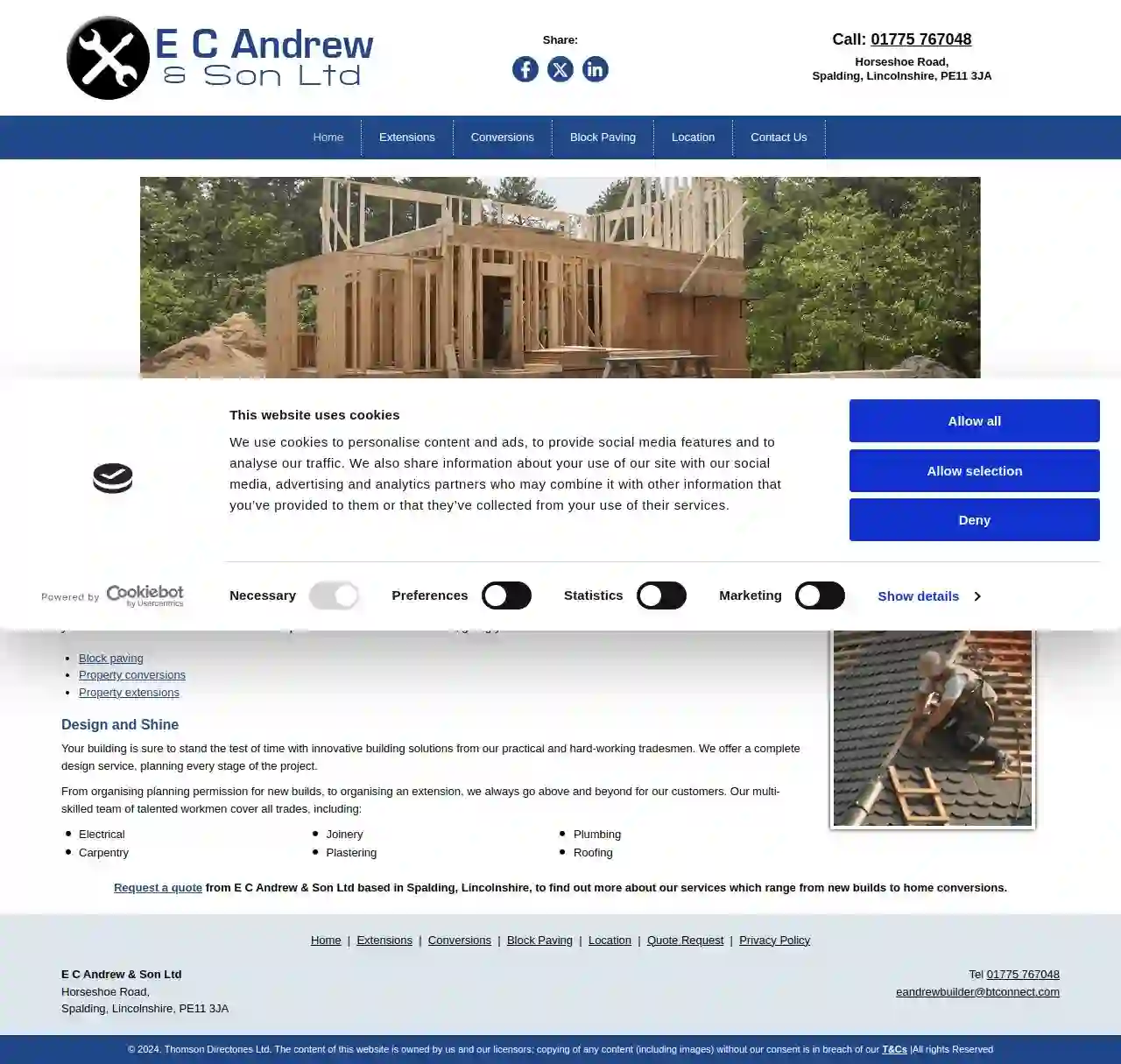
E Andrew Building Contractor
51 reviewsHorseshoe Road, Spalding, PE11 3JA, GBYou can count on us for outstanding results. E C Andrew & Son Ltd are reliable builders from Spalding, Lincolnshire, who specialise in both property conversions and new builds. With a second-to-none reputation, E C Andrew & Son Ltd are the region's leading building firm. Our experienced and knowledgeable builders work with your own designs, bringing the home of your dreams to fruition. As a family-run business, we take a more personal approach to every job and take great pride in delivering the reliable and professional service you deserve. Much of our work stems from repeat customer recommendations, giving you added reassurance. We cover: Block paving Property conversions Property extensions Your building is sure to stand the test of time with innovative building solutions from our practical and hard-working tradesmen. We offer a complete design service, planning every stage of the project. From organising planning permission for new builds, to organising an extension, we always go above and beyond for our customers. Our multi-skilled team of talented workmen cover all trades, including: Electrical Joinery Plumbing Carpentry Plastering Roofing
- Services
- Why Us?
- Gallery
Get Quote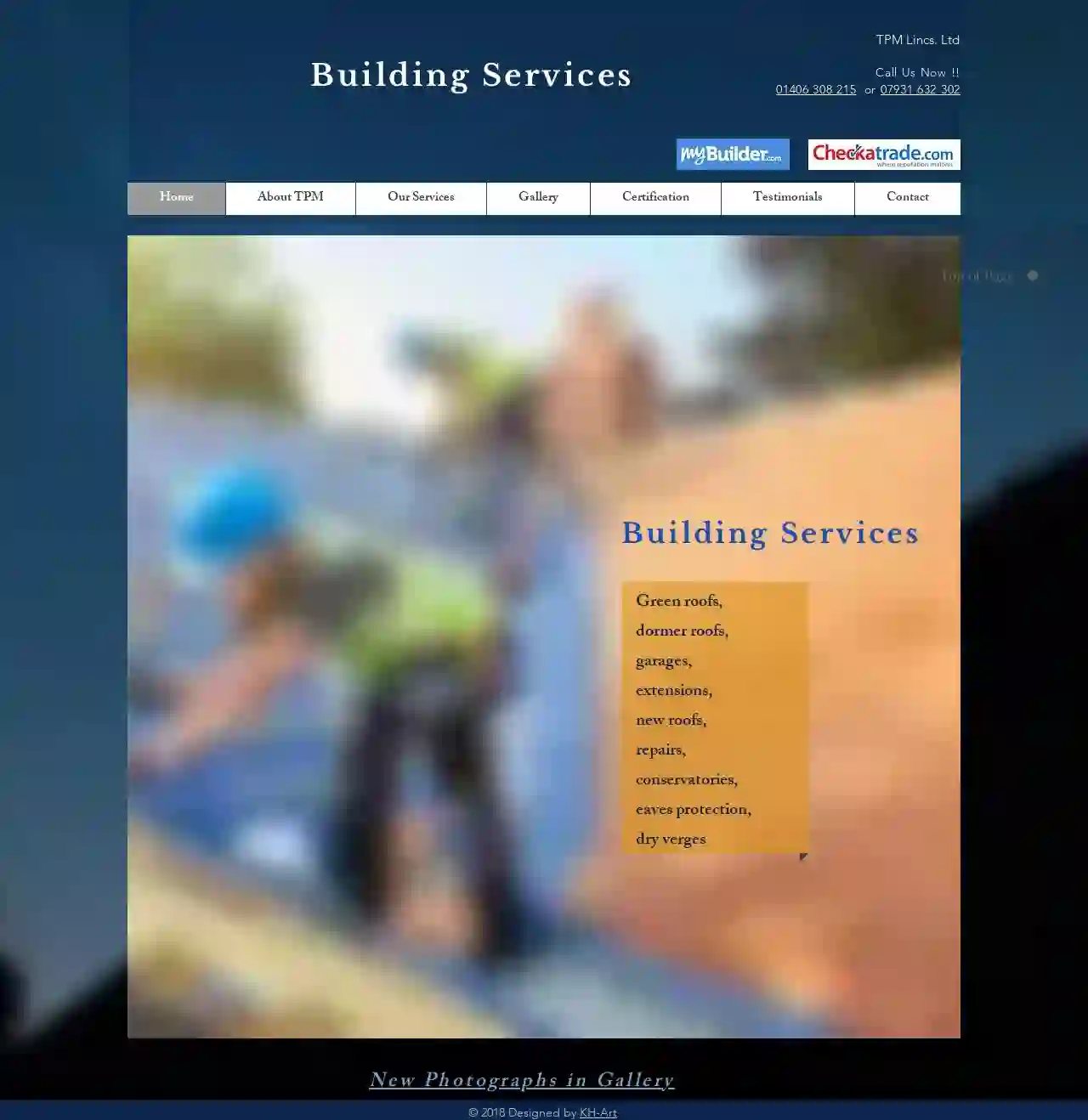
TPM Lincs Ltd
55 reviewsSpalding, GBTPM Building Services TPM Lincs. Ltd is a roofing company based in Lincolnshire. They offer a wide range of roofing services, including new roofs, repairs, extensions, garages, and green roofs. They are a trusted roofing company with a team of experienced professionals.
- Services
- Why Us?
- Gallery
Get Quote
Over 12,314+ Roofers onboarded
Our roofing contractors operate in Spalding & surroundings!
Roofyng.co.uk has curated and vetted Top Roofing Companies near Spalding. Find a trustworthy contractor today.
Frequently Asked Questions About Roofing Companies
- Experience: Companies with a solid track record and years of experience in the industry.
- Licensing and Insurance: Verify they are properly licensed to operate in your area and carry adequate insurance to protect you from liability.
- Certifications: Look for certifications from reputable organizations, demonstrating expertise in specific roofing materials or techniques.
- Positive Reviews: Check online reviews and testimonials from previous customers.
- Professionalism: Choose a company that communicates clearly, provides detailed estimates, and has a courteous and responsive team.
- Asphalt Shingles: Popular, affordable, available in various styles (3-tab, architectural, etc.)
- Metal Roofing: Durable, long-lasting, energy-efficient, available in panels, shingles, or tiles.
- Tile Roofing: Clay, concrete, or slate; known for longevity, durability, and aesthetic appeal.
- Flat Roofing: EPDM rubber, TPO, PVC, modified bitumen, or built-up roofing (BUR).
- Slate: Natural stone, extremely durable, expensive, requires expert installation.
- Wood Shakes or Shingles: Natural wood, aesthetically pleasing, requires regular maintenance.
- Ventilation: Soffit vents provide intake ventilation, allowing fresh air to enter the attic and regulate temperature and moisture.
- Aesthetics: It creates a finished look to the roof's underside.
- Pest Control: A properly sealed soffit prevents pests like birds and squirrels from nesting in the attic.
How do I find a good roofing company?
What are the different types of roofing materials?
What is a soffit, and why is it important for my roof?
What should I do with my old roof after replacement?
How do I find a good roofing company?
- Experience: Companies with a solid track record and years of experience in the industry.
- Licensing and Insurance: Verify they are properly licensed to operate in your area and carry adequate insurance to protect you from liability.
- Certifications: Look for certifications from reputable organizations, demonstrating expertise in specific roofing materials or techniques.
- Positive Reviews: Check online reviews and testimonials from previous customers.
- Professionalism: Choose a company that communicates clearly, provides detailed estimates, and has a courteous and responsive team.
What are the different types of roofing materials?
- Asphalt Shingles: Popular, affordable, available in various styles (3-tab, architectural, etc.)
- Metal Roofing: Durable, long-lasting, energy-efficient, available in panels, shingles, or tiles.
- Tile Roofing: Clay, concrete, or slate; known for longevity, durability, and aesthetic appeal.
- Flat Roofing: EPDM rubber, TPO, PVC, modified bitumen, or built-up roofing (BUR).
- Slate: Natural stone, extremely durable, expensive, requires expert installation.
- Wood Shakes or Shingles: Natural wood, aesthetically pleasing, requires regular maintenance.
What is a soffit, and why is it important for my roof?
- Ventilation: Soffit vents provide intake ventilation, allowing fresh air to enter the attic and regulate temperature and moisture.
- Aesthetics: It creates a finished look to the roof's underside.
- Pest Control: A properly sealed soffit prevents pests like birds and squirrels from nesting in the attic.